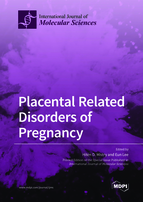Placental Related Disorders of Pregnancy
A special issue of International Journal of Molecular Sciences (ISSN 1422-0067). This special issue belongs to the section "Molecular Immunology".
Deadline for manuscript submissions: closed (30 September 2021) | Viewed by 67496
Special Issue Editors
Interests: pathophysiology of the hypertensive diseases of pregnancy; nutrition in pregnancy; global women’s health research studies
Special Issues, Collections and Topics in MDPI journals
Interests: determining the pathogenesis and genetic association of preeclampsia; preterm birth and spontaneous miscarriages; ERAP2 peptide processing and its immunological roles; targeting ERAP2 for immunotherap
Special Issue Information
Dear Colleagues,
The placenta is a unique organ, produced outside the embryo, connected by a cord of vessels and is formed as a result of various degrees of interactions between fetal and maternal tissues within the pregnant uterus. The placenta fulfils a variety of functions, which are completed by several different organs in adult life. Unlike the relatively stable mature adult organs, the placenta is programmed to complete very different functions during development. Thus, the placenta can be described as a constantly evolving organ. Its major role is the homeostasis of a protected environment for the undisturbed growth and development of the embryo/fetus.
Placental-related disorders of pregnancy are almost unique to the human species, which affect around a third of human pregnancies. Many of these disorders result in increased maternal and fetal mortality and morbidity and can have life-long health implications for both the mother and her child. Recent changes in human lifestyle, such as delayed childbirth and hypercaloric diets, may have increased the global incidence of placental-related disorders over the last decades.
This Special Issue will cover all aspects placentation, with a particular focus on those related placental function and to disorders of pregnancy. Manuscripts related to any aspect of placental physiology, biochemistry and molecular biology, will be considered for this Special Issue, which will hope will be an excellent collection.
Dr. Hiten D Mistry
Dr. Eun Lee
Guest Editors
Manuscript Submission Information
Manuscripts should be submitted online at www.mdpi.com by registering and logging in to this website. Once you are registered, click here to go to the submission form. Manuscripts can be submitted until the deadline. All submissions that pass pre-check are peer-reviewed. Accepted papers will be published continuously in the journal (as soon as accepted) and will be listed together on the special issue website. Research articles, review articles as well as short communications are invited. For planned papers, a title and short abstract (about 100 words) can be sent to the Editorial Office for announcement on this website.
Submitted manuscripts should not have been published previously, nor be under consideration for publication elsewhere (except conference proceedings papers). All manuscripts are thoroughly refereed through a single-blind peer-review process. A guide for authors and other relevant information for submission of manuscripts is available on the Instructions for Authors page. International Journal of Molecular Sciences is an international peer-reviewed open access semimonthly journal published by MDPI.
Please visit the Instructions for Authors page before submitting a manuscript. There is an Article Processing Charge (APC) for publication in this open access journal. For details about the APC please see here. Submitted papers should be well formatted and use good English. Authors may use MDPI's English editing service prior to publication or during author revisions.
Keywords
- placentation
- pregnancy complications
- placental function
- disorders of pregnancy
- physiology and biochemistry







